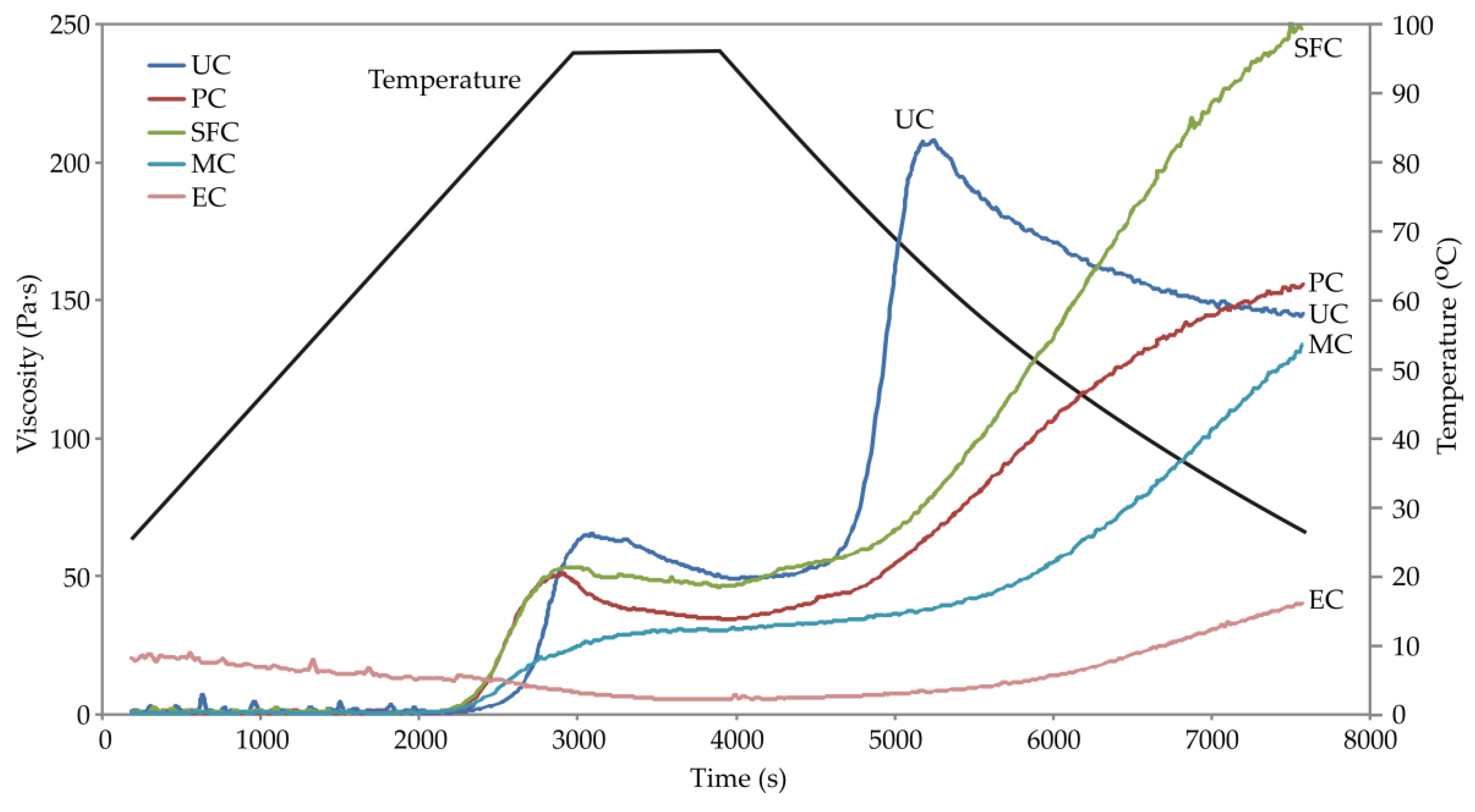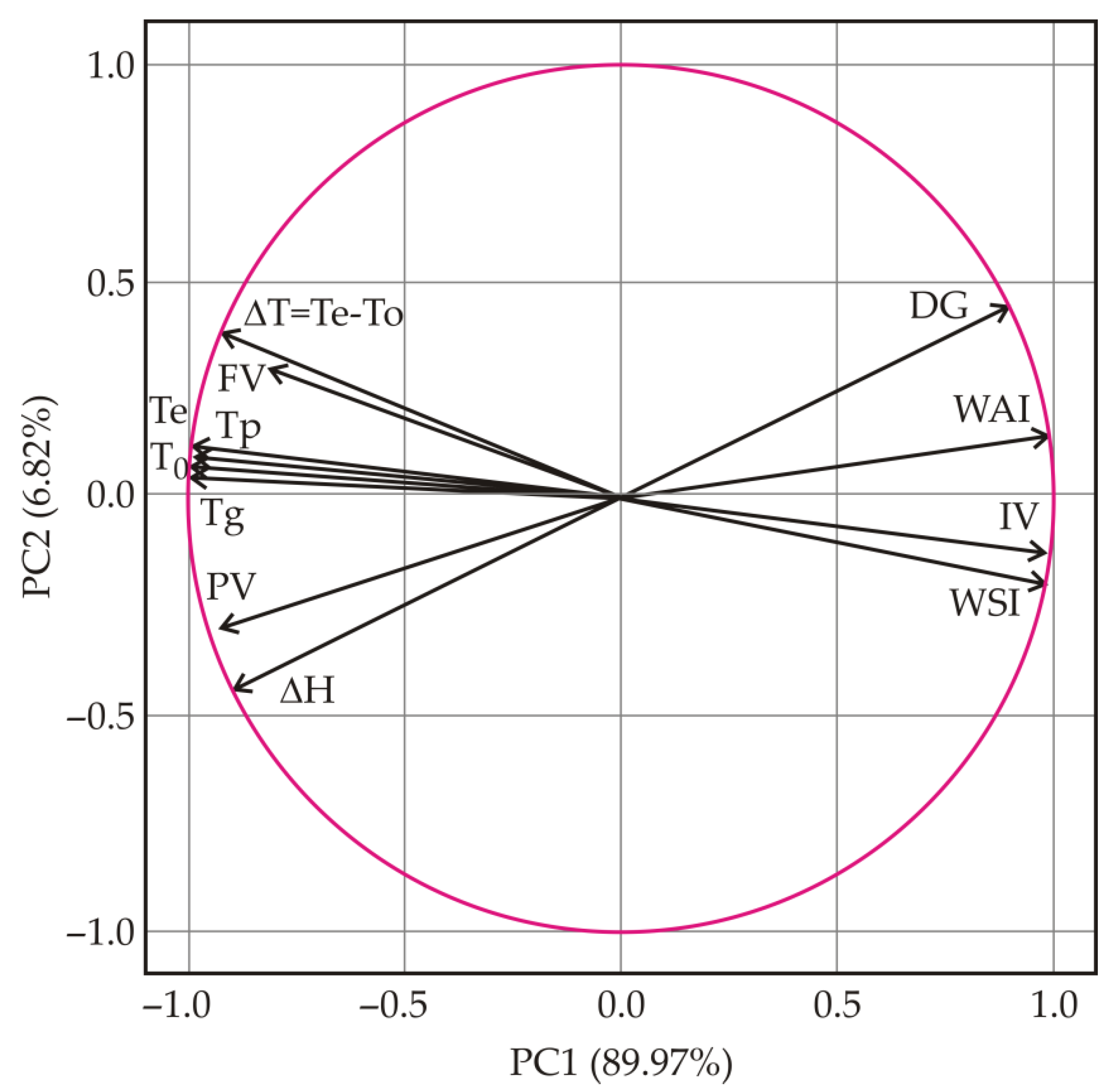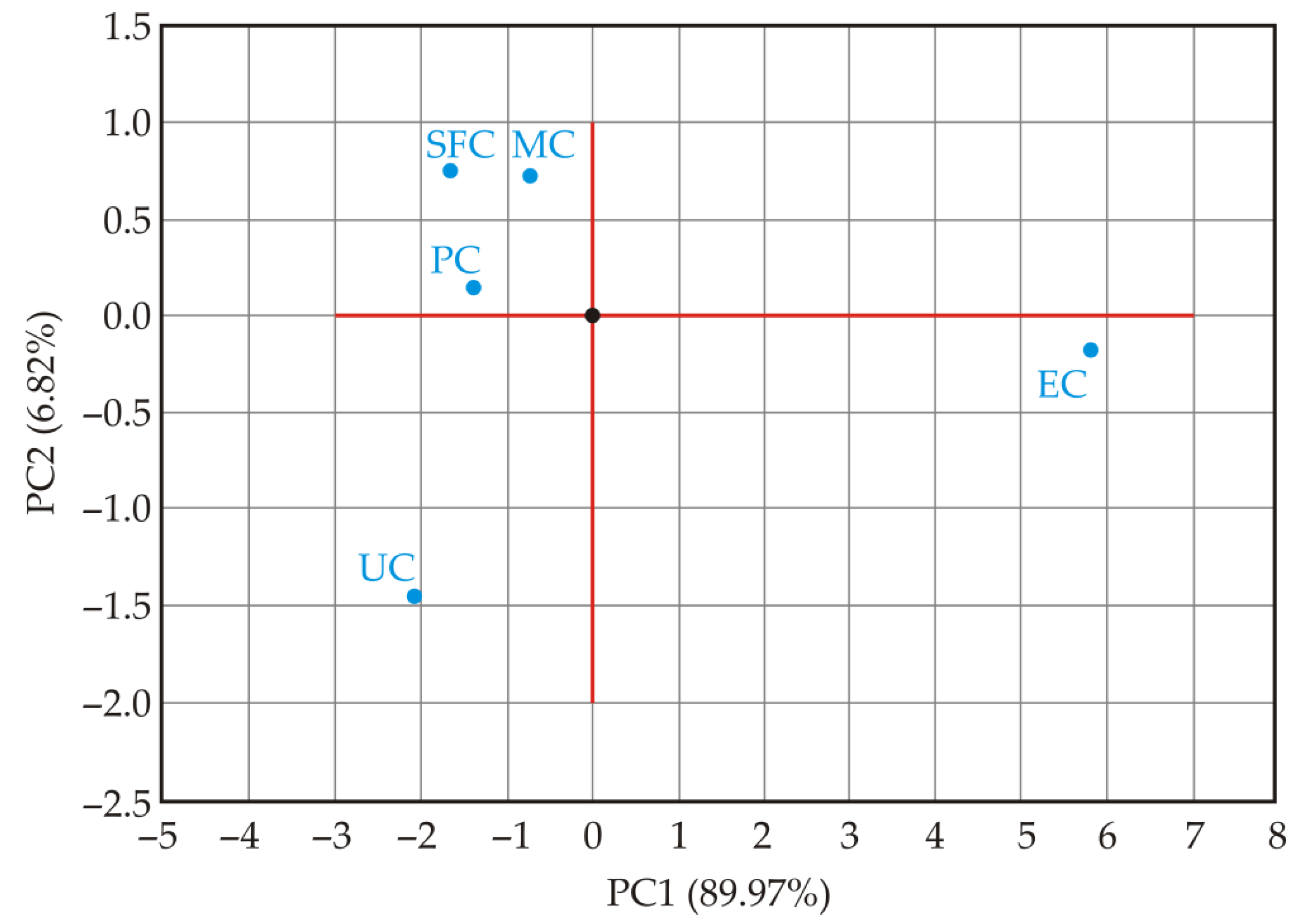Physicochemical Changes of Heat-Treated Corn Grain Used in Ruminant Nutrition
Abstract
:Simple Summary
Abstract
1. Introduction
2. Materials and Methods
2.1. Material
2.2. Heat Treatments
2.2.1. Steam Flaking
2.2.2. Micronization
2.2.3. Pelleting
2.2.4. Extrusion
2.3. Differential Scanning Calorimetry (DSC)
2.4. Water Absorption Index (WAI) and Water Solubility Index (WSI)
2.5. Paste Consistency (Pasting Profile)
2.6. Scanning Electron Microscopy (SEM)
2.7. Statistical Analysis
3. Results
3.1. Gelatinization Properties
3.2. Water Absorption Index (WAI) and Water Solubility Index (WSI)
3.3. Pasting Properties
3.4. Scanning Electron Microscopy (SEM)
3.5. Principle Component Analysis (PCA)
4. Discussion
4.1. Gelatinization Properties
4.2. Water Absorption Index (WAI) and Water Solubility Index (WSI)
4.3. Pasting Properties
4.4. Scanning Electron Microscopy (SEM)
5. Conclusions
Supplementary Materials
Author Contributions
Funding
Institutional Review Board Statement
Informed Consent Statement
Data Availability Statement
Conflicts of Interest
References
- Offner, A.; Bach, A.; Sauvant, D. Quantitative review of in situ starch degradation in the rumen. Anim. Feed Sci. Technol. 2003, 106, 81–93. [Google Scholar] [CrossRef]
- Gómez, L.M.; Posada, S.L.; Olivera, M. Starch in ruminant diets: A review. Rev. Colomb. Cienc. Pecu. 2016, 29, 77–90. [Google Scholar] [CrossRef]
- Luciano, A.; Tretola, M.; Ottoboni, M.; Baldi, A.; Cattaneo, D.; Pinotti, L. Potentials and Challenges of Former Food Products (Food Leftover) as Alternative Feed Ingredients. Animals 2020, 10, 125. [Google Scholar] [CrossRef] [PubMed]
- Huntington, G.B. Starch utilization by ruminants: From basics to the bunk. J. Anim. Sci. 1997, 75, 852–867. [Google Scholar] [CrossRef] [PubMed]
- Ørskov, E.R. Starch Digestion and Utilization in Ruminants. J. Anim. Sci. 1986, 63, 1624–1633. [Google Scholar] [CrossRef]
- Kotarski, S.F.; Waniska, R.D.; Thurn, K.K. Starch Hydrolysis by the Ruminal Microflora. J. Nutr. 1992, 122, 178–190. [Google Scholar] [CrossRef]
- Zinn, R.A.; Owens, F.N.; Ware, R.A. Flaking corn: Processing mechanics, quality standards, and impacts on energy availability and performance of feedlot cattle. J. Anim. Sci. 2002, 80, 1145–1156. [Google Scholar] [CrossRef]
- Theurer, C.B. Grain processing effects on starch utilization by ruminants. J. Anim. Sci. 1986, 63, 1649–1662. [Google Scholar] [CrossRef]
- Owens, F.N.; Zinn, R.A.; Kim, Y.K. Limits to starch digestion in the ruminant small intestine. J. Anim. Sci. 1986, 63, 1634–1648. [Google Scholar] [CrossRef]
- Blackwood, R.B. The Effect of Steam-Flaked Grain Sorghum and Corn On: I. Fat Utilization, Animal Performance, Carcass Composition, Yield, Quality, and Organoleptic Traits and II. Disulfide Linkage in the Protein Matrix of Starch. Ph.D. Thesis, Texas Tech University, Lubbock, TX, USA, August 1994. [Google Scholar]
- Chen, K.H.; Huber, J.T.; Theurer, C.B.; Swingle, R.S.; Simas, J.; Chan, S.C.; Wu, Z.; Sullivan, J.L. Effect of Steam Flaking of Corn and Sorghum Grains on Performance of Lactating Cows. J. Dairy Sci. 1994, 77, 1038–1043. [Google Scholar] [CrossRef]
- Theurer, C.B.; Huber, J.T.; Delgado-Elorduy, A.; Wanderley, R. Invited Review: Summary of Steam-Flaking Corn or Sorghum Grain for Lactating Dairy Cows. J. Dairy Sci. 1999, 82, 1950–1959. [Google Scholar] [CrossRef]
- Firkins, J.L.; Eastridge, M.L.; St-Pierre, N.R.; Noftsger, S.M. Effects of grain variability and processing on starch utilization by lactating dairy cattle. J. Anim. Sci. 2001, 79, E218–E238. [Google Scholar] [CrossRef]
- Cooper, R.; Milton, C.; Klopfenstein, T.J.; Scott, T.; Wilson, C.; Mass, R. Effect of corn processing on starch digestion and bacterial crude protein flow in finishing cattle. J. Anim. Sci. 2002, 80, 797–804. [Google Scholar] [CrossRef]
- Armbruster, S. Steam flaking grains for feedlot cattle: A consultant’s perspective. In Proceedings of the Cattle Grain Processing Symposium, Tulsa, OK, USA, 15–17 November 2006; pp. 46–55. [Google Scholar]
- Matsushima, J.K. History of feed processing. In Proceedings of the Cattle Grain Proccessing Symposium, Tulsa, OK, USA, 15–17 November 2006; pp. 1–16. [Google Scholar]
- Hristov, A.; Zaman, S.; VanderPol, M.; Szasz, P.; Huber, K.; Greer, D. Effect of a saponin-based surfactant and aging time on ruminal degradability of flaked corn grain dry matter and starch. J. Anim. Sci. 2007, 85, 1459–1466. [Google Scholar] [CrossRef]
- Domby, E.M. Interactive Effects of Bulk Density of Steam-Flaked Corn and Concentration of Sweet Bran Wet Corn Gluten Feed on Feedlot Cattle Performance, Carcass Characteristics, and Apparent Total Tract Nutrient Digestibility. Ph.D. Thesis, Texas Tech University, Lubbock, TX, USA, August 2013. [Google Scholar]
- Horton, L.M.; Van Bibber-Krueger, C.L.; Müller, H.C.; Drouillard, J.S. Effects of high-amylase corn on performance and carcass quality of finishing beef heifers. J. Anim. Sci. 2020, 98, skaa302. [Google Scholar] [CrossRef]
- De Melo, A.H.F.; Marques, R.S.; Gouvêa, V.N.; de Souza, J.; Batalha, C.D.A.; Basto, D.C.; Millen, D.D.; Drouillard, J.S.; Santos, F.A.P. Effects of dietary roughage neutral detergent fiber levels and flint corn processing method on growth performance, carcass characteristics, feeding behavior, and rumen morphometrics of Bos indicus cattle. J. Anim. Sci. 2019, 97, 3562–3577. [Google Scholar] [CrossRef]
- Johnson, J.A.; Sutherland, B.D.; McKinnon, J.J.; McAllister, T.A.; Penner, G.B. Effect of feeding barley or corn silage with dry-rolled barley, corn, or a blend of barley and corn grain on rumen fermentation, total tract digestibility, and nitrogen balance for finishing beef heifers. J. Anim. Sci. 2020, 98, skaa002. [Google Scholar] [CrossRef]
- Kang, H.; Lee, M.; Jeon, S.; Lee, S.M.; Lee, J.H.; Seo, S. Effect of flaking on the digestibility of corn in ruminants. J. Anim. Sci. Technol. 2021, 63, 1018–1033. [Google Scholar] [CrossRef]
- Malekkhahi, M.; Naserian, A.A.; Rahimi, A.; Bazgir, A.; Vyas, D.; Razzaghi, A. Effects of ground, steam-flaked, and super-conditioned corn grain on production performance and total-tract digestibility in dairy cows. J. Dairy Sci. 2021, 104, 6756–6767. [Google Scholar] [CrossRef] [PubMed]
- Han, C.; Guo, Y.; Cai, X.; Yang, R. Starch Properties, Nutrients Profiles, In Vitro Ruminal Fermentation and Molecular Structure of Corn Processed in Different Ways. Fermentation 2022, 8, 315. [Google Scholar] [CrossRef]
- Owens, F.N.; Secrist, D.S.; Hill, W.J.; Gill, D.R. The effect of grain source and grain processing on performance of feedlot cattle: A review. J. Anim. Sci. 1997, 75, 868–879. [Google Scholar] [CrossRef] [PubMed]
- Von Keyserlingk, M.A.G.; Gardner, W.C.; Fisher, L.J.; Shelford, J.A. A comparison of textured versus pelleted concentrates on rumen degradability, dry matter intake, milk yield and composition in lactating Holstein cows. Can. J. Anim. Sci. 1998, 78, 219–224. [Google Scholar] [CrossRef]
- Razzaghi, A.; Larsen, M.; Lund, P.; Weisbjerg, M.R. Effect of conventional and extrusion pelleting on in situ ruminal degradability of starch, protein, and fibre in cattle. Livest. Sci. 2016, 185, 97–105. [Google Scholar] [CrossRef]
- Shabi, Z.; Bruckental, I.; Zamwell, S.; Tagari, H.; Arieli, A. Effects of extrusion of grain and feeding frequency on rumen fermentation, nutrient digestibility, and milk yield and composition in dairy cows. J. Dairy Sci. 1999, 82, 1252–1260. [Google Scholar] [CrossRef]
- Karami, M.; Palizdar, M.; Almasi, M. The effect of different processing of corn grain on gas production kinetics and in vitro digestibility in Taleshi cows. J. Livest. Sci. 2018, 9, 101–106. [Google Scholar]
- Buenabad, L.; Jacinto, A.; Montano, M.; Zinn, R. Extruded Corn Meal as a Partial Replacement for Steam Flaked Corn in Finishing Diets for Feedlot Cattle: Growth Performance and Digestive Function of Feedlot Cattle. Open J. Anim. Sci. 2019, 9, 196–206. [Google Scholar] [CrossRef]
- Tothi, R.; Lund, P.; Weisbjerg, M.R.; Hvelplund, T. Effect of expander processing on fractional rate of maize and barley starch degradation in the rumen of dairy cows estimated using rumen evacuation and in situ techniques. Anim. Feed Sci. Technol. 2003, 104, 71–94. [Google Scholar] [CrossRef]
- Hale, W.H. Influence of Processing on the Utilization of Grains (Starch) by Ruminants. J. Anim. Sci. 1973, 37, 1075–1080. [Google Scholar] [CrossRef]
- White, G.A.; Doucet, F.J.; Hill, S.E.; Wiseman, J. Physicochemical changes to starch granules during micronisation and extrusion processing of wheat, and their implications for starch digestibility in the newly weaned piglet. Animal 2008, 2, 1312–1323. [Google Scholar] [CrossRef]
- Huang, T.-T.; Zhou, D.-N.; Jin, Z.-Y.; Xu, X.-M.; Chen, H.-Q. Effect of repeated heat-moisture treatments on digestibility, physicochemical and structural properties of sweet potato starch. Food Hydrocoll. 2016, 54, 202–210. [Google Scholar] [CrossRef]
- Lazou, A.; Krokida, M. Functional properties of corn and corn–lentil extrudates. Food Res. Int. 2010, 43, 609–616. [Google Scholar] [CrossRef]
- Butrim, S.; Litvyak, V.; Moskva, V. A study of physicochemical properties of extruded starches of varied biological origin. Russ. J. Appl. Chem. 2009, 82, 1195–1199. [Google Scholar] [CrossRef]
- Singh, N.; Singh, J.; Kaur, L.; Singh Sodhi, N.; Singh Gill, B. Morphological, thermal and rheological properties of starches from different botanical sources. Food Chem. 2003, 81, 219–231. [Google Scholar] [CrossRef]
- Altay, F.; Gunasekaran, S. Influence of drying temperature, water content, and heating rate on gelatinization of corn starches. J. Agric. Food Chem. 2006, 54, 4235–4245. [Google Scholar] [CrossRef]
- Wang, S.; Copeland, L. Molecular disassembly of starch granules during gelatinization and its effect on starch digestibility: A review. Food Funct. 2013, 4, 1564–1580. [Google Scholar] [CrossRef]
- Svihus, B.; Kløvstad, K.H.; Perez, V.; Zimonja, O.; Sahlström, S.; Schüller, R.B.; Jeksrud, W.K.; Prestløkken, E. Physical and nutritional effects of pelleting of broiler chicken diets made from wheat ground to different coarsenesses by the use of roller mill and hammer mill. Anim. Feed Sci. Technol. 2004, 117, 281–293. [Google Scholar] [CrossRef]
- Medel, P.; Latorre, M.A.; de Blas, C.; Lázaro, R.; Mateos, G.G. Heat processing of cereals in mash or pellet diets for young pigs. Anim. Feed Sci. Technol. 2004, 113, 127–140. [Google Scholar] [CrossRef]
- Qiao, F.-Q.; Wang, F.; Ren, L.-P.; Zhou, Z.-M.; Meng, Q.-X.; Bao, Y.-H. Effect of steam-flaking on chemical compositions, starch gelatinization, in vitro fermentability, and energetic values of maize, wheat and rice. J. Integr. Agric. 2015, 14, 949–955. [Google Scholar] [CrossRef]
- Medel, P.; Salado, S.; De Blas, J.; Mateos, G. Processed cereals in diets for early-weaned piglets. Anim. Feed Sci. Technol. 1999, 82, 145–156. [Google Scholar] [CrossRef]
- Moritz, J.; Parsons, A.; Buchanan, N.; Calvalcanti, W.; Cramer, K.; Beyer, R. Effect of gelatinizing dietary starch through feed processing on zero-to three-week broiler performance and metabolism. J. Appl. Poult. Res. 2005, 14, 47–54. [Google Scholar] [CrossRef]
- Svihus, B.; Zimonja, O. Chemical alterations with nutritional consequences due to pelleting animal feeds: A review. Anim. Prod. Sci. 2011, 51, 590–596. [Google Scholar] [CrossRef]
- Svihus, B.; Uhlen, A.K.; Harstad, O.M. Effect of starch granule structure, associated components and processing on nutritive value of cereal starch: A review. Anim. Feed Sci. Technol. 2005, 122, 303–320. [Google Scholar] [CrossRef]
- Hajnal, E.J.; Čolović, R.; Pezo, L.; Orčić, D.; Vukmirović, Đ.; Mastilović, J. Possibility of Alternaria toxins reduction by extrusion processing of whole wheat flour. Food Chem. 2016, 213, 784–790. [Google Scholar] [CrossRef]
- Al-Rabadi, G.J.; Torley, P.J.; Williams, B.A.; Bryden, W.L.; Gidley, M.J. Particle size of milled barley and sorghum and physico-chemical properties of grain following extrusion. J. Food Eng. 2011, 103, 464–472. [Google Scholar] [CrossRef]
- White, G.; Doucet, F.; Hill, S.; Wiseman, J. Physicochemical properties and nutritional quality of raw cereals for newly weaned piglets. Animal 2008, 2, 867–878. [Google Scholar] [CrossRef]
- Dogan, H.; Karwe, M. Physicochemical properties of quinoa extrudates. Food Sci. Technol. Int. 2003, 9, 101–114. [Google Scholar] [CrossRef]
- Altan, A.; McCarthy, K.; Maskan, M. Effect of Extrusion Cooking on Functional Properties and in vitro Starch Digestibility of Barley-Based Extrudates from Fruit and Vegetable By-Products. J. Food Sci. 2009, 74, E77–E86. [Google Scholar] [CrossRef]
- Gomez, M.; Aguilera, J. A physicochemical model for extrusion of corn starch. J. Food Sci. 1984, 49, 40–43. [Google Scholar] [CrossRef]
- Zeng, J.; Gao, H.; Li, G.; Liang, X. Extruded corn flour changed the functionality behaviour of blends. Czech J. Food Sci. 2011, 29, 520–527. [Google Scholar] [CrossRef]
- Mahasukhonthachat, K.; Sopade, P.; Gidley, M. Kinetics of starch digestion and functional properties of twin-screw extruded sorghum. J. Cereal Sci. 2010, 51, 392–401. [Google Scholar] [CrossRef]
- Menegassi, B.; Pilosof, A.M.; Areas, J.A. Comparison of properties of native and extruded amaranth (Amaranthus cruentus L.–BRS Alegria) flour. LWT-Food Sci. Technol. 2011, 44, 1915–1921. [Google Scholar] [CrossRef]
- Ozcan, S.; Jackson, D.S. Functionality Behavior of Raw and Extruded Corn Starch Mixtures. Cereal Chem. J. 2005, 82, 223–227. [Google Scholar] [CrossRef]
- Deepa, C.; Hebbar, H.U. Influence of micronization on physicochemical properties of maize grains. Starch/Stärke 2016, 68, 1600060. [Google Scholar] [CrossRef]
- Liu, Q. Understanding Starches and Their Role in Foods. In Food Carbohydrates: Chemistry, Physical Properties, and Applications; Cui, S.W., Ed.; CRC Press: Boca Raton, FL, USA, 2005; pp. 309–355. [Google Scholar]
- Souza, V.; Ortiz, J.; Nascimento, E. Pasting properties of expanded extrudate and pellets from corn flour and rice flour. Braz. J. Food Technol. 2011, 14, 106–114. [Google Scholar] [CrossRef]
- Gidley, M.; Sopade, P.; Al-Rabadi, G.; Williams, B.; Black, J. Processing Methods for Improving the Utilisation of Cereal Grains by Pigs; Centre for Nutrition and Food Sciences, The University of Queensland: Brisbane, Australia, 2010; pp. 1–71. [Google Scholar]
- Smith, K.J. Advances in Steam-Flaking Grain Sorghum and Predicting Starch Availability for Cattle. Ph.D. Thesis, Texas Tech University, Lubbock, TX, USA, December 1995. [Google Scholar]
- McNeill, J.; Potter, G.; Riggs, J.; Rooney, L. Chemical and physical properties of processed sorghum grain carbohydrates. J. Anim. Sci. 1975, 40, 335–341. [Google Scholar] [CrossRef]
- Sandhu, K.S.; Singh, N. Some properties of corn starches II: Physicochemical, gelatinization, retrogradation, pasting and gel textural properties. Food Chem. 2007, 101, 1499–1507. [Google Scholar] [CrossRef]
- Harbers, L. Starch granule structural changes and amylolytic patterns in processed sorghum grain. J. Anim. Sci. 1975, 41, 1496–1501. [Google Scholar] [CrossRef]
- Bdour, M.A.; Al-Rabadi, G.J.; Al-Ameiri, N.S.; Mahadeen, A.Y.; Aaludatt, M.H. Microscopic analysis of extruded and pelleted barley and sorghum grains. Jordan J. Biol. Sci. 2014, 7, 227–231. [Google Scholar]





| Properties | UC | PC | SFC | MC | EC |
|---|---|---|---|---|---|
| Gelatinization | |||||
| To (°C) | 71.0 ± 0.1 c | 67.1 ± 0.2 a | 66.9 ± 0.2 a | 68.7 ± 0.1 b | /† |
| Tp (°C) | 75.6 ± 0.2 c | 75.0 ± 0.3 b | 73.4 ± 0.2 a | 75.7 ± 0.1 c | / |
| Te (°C) | 79.4 ± 0.2 b | 79.4 ± 0.3 b | 78.8 ± 0.2 a | 80.3 ± 0.2 c | / |
| ∆T = Te − To (°C) | 8.4 ± 0.1 a | 12.3 ± 0.2 c | 11.9 ± 0.3 bc | 11.6 ± 0.1 b | / |
| ∆H (J/g) | 4.30 ± 0.09 d | 2.77 ± 0.07 c | 2.47 ± 0.05 b | 2.08 ± 0.10 a | / |
| DG (%) | 0.00 a | 35.64 ± 1.17 b | 42.51 ± 1.90 c | 51.74 ± 2.22 d | 100e |
| Functional (hydration) | |||||
| WAI (g/g) | 2.77 ± 0.11 a | 3.35 ± 0.08 b | 3.55 ± 0.09 bc | 3.86 ± 0.10 c | 6.59 ± 0.20 d |
| WSI (g/100 g) | 6.20 ± 0.19 b | 6.11 ± 0.30 b | 3.37 ± 0.42 a | 5.91 ± 0.12 b | 20.89 ± 0.91 c |
| Pasting | |||||
| IV (Pa·s) | 1.07 ± 0.09 c | 0.42 ± 0.01 a | 0.77 ± 0.02 b | 0.49 ± 0.04 ab | 19.90 ± 0.24 d |
| PV (Pa·s) | 68.06 ± 2.85 c | 50.03 ± 0.07 b | 53.46 ± 0.22 b | 30.41 ± 0.08 a | / |
| FV (Pa·s) | 149.80 ± 5.00 c | 157.29 ± 1.70 d | 248.60 ± 0.70 e | 130.55 ± 3.05 b | 39.61 ± 0.74 a |
| Tg (°C) | 77.72 ± 0.02 d | 72.83 ± 0.31 b | 73.57 ± 0.01 c | 72.14 ± 0.29 a | / |
Publisher’s Note: MDPI stays neutral with regard to jurisdictional claims in published maps and institutional affiliations. |
© 2022 by the authors. Licensee MDPI, Basel, Switzerland. This article is an open access article distributed under the terms and conditions of the Creative Commons Attribution (CC BY) license (https://creativecommons.org/licenses/by/4.0/).
Share and Cite
Kokić, B.; Dokić, L.; Pezo, L.; Jovanović, R.; Spasevski, N.; Kojić, J.; Hadnađev, M. Physicochemical Changes of Heat-Treated Corn Grain Used in Ruminant Nutrition. Animals 2022, 12, 2234. https://doi.org/10.3390/ani12172234
Kokić B, Dokić L, Pezo L, Jovanović R, Spasevski N, Kojić J, Hadnađev M. Physicochemical Changes of Heat-Treated Corn Grain Used in Ruminant Nutrition. Animals. 2022; 12(17):2234. https://doi.org/10.3390/ani12172234
Chicago/Turabian StyleKokić, Bojana, Ljubica Dokić, Lato Pezo, Rade Jovanović, Nedeljka Spasevski, Jovana Kojić, and Miroslav Hadnađev. 2022. "Physicochemical Changes of Heat-Treated Corn Grain Used in Ruminant Nutrition" Animals 12, no. 17: 2234. https://doi.org/10.3390/ani12172234
APA StyleKokić, B., Dokić, L., Pezo, L., Jovanović, R., Spasevski, N., Kojić, J., & Hadnađev, M. (2022). Physicochemical Changes of Heat-Treated Corn Grain Used in Ruminant Nutrition. Animals, 12(17), 2234. https://doi.org/10.3390/ani12172234






